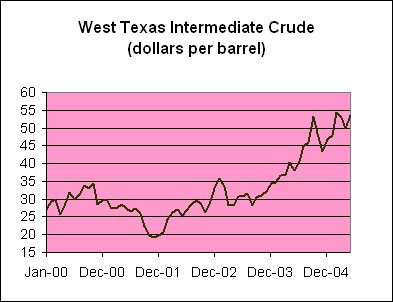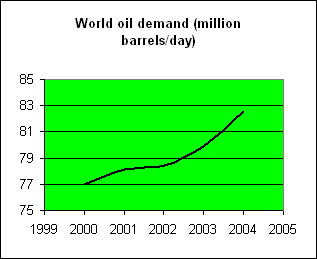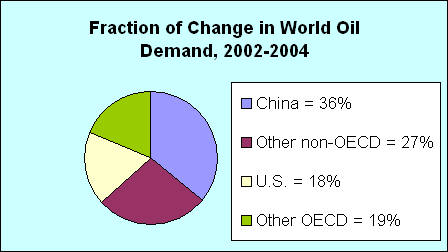Oil prices made the third sustained run above $50 that we have seen over the last 9 months. Although the week-to-week price changes have been quite volatile, it appears that long-run factors, particularly strong oil demand from China and other developing counries, is the major story here.
During the last two weeks, the price of West Texas intermediate crude oil moved quickly back up above $50 a barrel, a level that has been shakily sustained since last October and is nearly double the $30/barrel values that were observed during most of 2003. The up and down price moves on a week-to-week basis are certainly impressive, but should not obscure the long-run trend of a substantial move up in oil prices since the fall of 2003.
Neither the week-to-week volatility nor the long-run trend can be explained by tangible developments on the supply side of the market. The sustained run-up in oil prices has coincided with a large increase, not decrease, in world oil production. World oil production had previously fallen off in response to the lower demand brought about by the recession of 2001, a time when oil prices were soft as well. Oil prices then rebounded as the global economy recovered, with growth of both particularly impressive in 2004. It is clear that demand, not supply, has been
the overall factor driving world oil prices over the past several years.
Many people assume that the most important buyers on the world energy market are the major developed countries that are members of the Organization of Economic Cooperation and Development, which includes the U.S., Canada, Mexico, Japan, Korea, and most of the major European countries. These countries currently account for 60% of global petroleum demand, with 25% of the world total accounted for by the U.S. alone.
But while the OECD countries account for more than half of total world petroleum use, the explanation for surging world oil demand lies elsewhere. The world as a whole is consuming 82.5 million barrels a day today, which represents an increase of 4 million barrels a day over the level in 2002. Of the current 82.5 million total, China accounts for 6.5 million barrels a day, or 8% of world petroleum use. But in 2002, China was only using 5 million barrels a day. This increase of 1.5 million barrels a day from China in fact accounts for 36% of the total global increase over the last two years. The non-OECD countries combined account for 63% of the increase in global petroleum demand over the last two years.
The increase in Chinese demand is primarily driven by the phenomenal growth of the Chinese economy,whose real output has increased 8% annually over the last two decades. China may or may not be able to sustain such incredible growth over the next decade. But what is abundantly clear is that world oil production can not continue to increase at the same pace. The geological and engineering realities of oil production guarantee that the rate of increase in Chinese oil demand will of necessity be restrained, through some combination of a slowing of Chinese economic growth and the energy conservation incentives that are an inevitable consequence of higher oil prices.
How high do oil prices need to be in order to enforce this conservation on China and the rest of the world? That’s a hard question to answer, and its resolution by the market in part comes from a trial and error process, whose consequences we see in the high week-to-week volatility of oil prices, as the market searches for the price that equilibrates supply with demand. But there is no missing the fact that east Asia is the place to watch for what’s going to happen to oil prices over the next decade.




It’s funny that when you see a chart like your “World Oil Demand” you could also label it “World Oil Supply” and it would be the same data. But it kind of has a different meaning and connotation depending on the label.
Perhaps the doubling of M3 in the last seven years also has something to do with it?
This is probably a stupid question, but hope someone here can answer it. Has the actuall price of oil really risen that much? Isn’t a lot of it just the weak dollar?
Oil may be traded in dollars, but you pay in your own goods. How much has the price of oil actually risen when calcualted on the World currency?
Example: When oil was 25 and the Dollar 1.2 you would have to pay 30 Euros per barrel, now oil is 50 and the dollar 0.8 and you have to pay 40 euros. From Europes point of view oil has only risen by a third, not doubled as it has for the US.
Since the dollar has fallen by roughly 20% against the average world currency in the period where oil doubled from 25-50, the actual rise in the price of oil the world faces would be 25-40, i.e 60% rather than 100%.
Am I wrong, if so why?
Tino-
I think you’re correct in saying that the recent strenth in the Euro vs. Dollar has softened the impact of rising oil prices in countries that use the Euro (also the Yen). However, in terms of the US’s viewpoint, the rise in oil prices has been very significant and cannot be accounted for by a weakness in the dollar. This is much more simply a supply/demand issue with countries like China/India fueling the growth in demand; while a combination of geo-political events like the recent strike in Venezuela and Iraq war along with theories like Hubbert’s Peak(peak oil) affecting the supply side of the equation. More oil is needed than ever, and it is getting increasingly difficult to get it out of the ground – simple as that.
Even if a stronger currency makes it cheaper for Europeans to purchase oil relative to Americans, a 60% increase is still pretty significant; and if prices continue to rise, which I believe is what the long-term trend is going to be, that 60% could be 100-300% in a short time. Also consider that much of the world’s economies are tied to how well the US is doing – a rise in oil prices will have an indirect effect on those economies if there is a slowdown in growth due to rising oil. I hope this was helpful.